Documentary
![]()
The Unsung Experts of Japan | Japan in Focus | Discover Asia | Japan’s Unsung Masters - Live! | NINJA | BOSAI: Be Prepared |
Preserving the Future~The Challenges of Restoring a National Treasure~
DC271636![]()
よみがえる国宝 瑞厳寺~平成の大修理 100年先に繋ぐ匠の技~ [KHB]
![]()
![]()
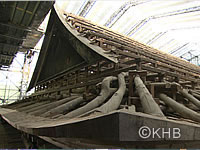
|Length : 50min |Year : 2016 |
Majestic Zuigan-ji Temple in the northeast Japan is a national cultural treasure. Completed 400 years ago by the feudal lord of the region, Date Masamune, it’s famous as a lavish and glorious example of the culture of the Azuchi-Momoyama period. With ground subsidence now causing its pillars to tilt, Zuigan-ji has been undergoing comprehensive repairs and restorations since 2009, called "the great Heisei restoration." An essential consideration in the repair of Japanese cultural properties is that old and weathered parts must not be replaced and existing original materials must be reused to the greatest possible extent. The restoration's greatest hurdle was to reinforce the structure against earthquakes.
Trace of the History of Ise Gran-Shrine: Treasures of the Land of the Rising Sun
DC271535![]()
時を紡いで~美し国の宝~ [MTV]
![]()
![]()
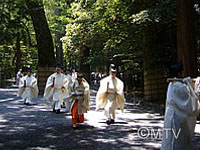
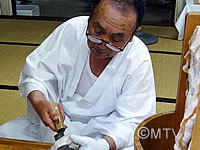
|Length : 46min |Year : 2015 |
Ise Gran-Shrine in Ise City, Mie prefecture, is thought to be the spiritual home for Japanese, and has been the center of Shinto for more than 1000 years. In 2010, more than 8.6 million people including the young and foreigners visited the shrine, which is the highest number in a century.
Shikinen Sengu is the most important ritual, which is held once every 20 years. It involves the reconstruction of the buildings, as well as renewal of the sacred apparel and the treasures carried to the new sanctuary. Sacred apparel and treasures associated with the deities are offered to the shrine at Sengu held every 20 years from 1300 years ago.
Moreover, local residents who live on the land that once belonged to the shrine have kept working for the shrine by making salt or weaving. This program also introduces the local people’s sincere minds for facing God.
Home to the Finest Craftsmen
DC271434![]()
手わざ恋々和美巡り [BS4]
![]()
![]()


|Length : 54min. |Year : 2014 |
Join actress Rei Dan on a visit to Kanazawa, in the ancient Japanese domain of Kaga. Rei looks into the amazing story of gold leaf craftsmanship here that dates back to the 17th century. Find out how Kanazawa became a center of the arts and culture and how many of those arts and crafts live on to this day. Luckily, Kanazawa was saved from much of the damage the country suffered during the last war and as a result much of the old town and residences still stand as they did when they were first built. Rei also visits various craftsmen and women to see how gold leafing has evolved and adapted to the changing times.
Kenka Tanabata : The Float Fighting Festival of Kesencho
DC271233![]()
日本の祭り「ぶつけろ、魂!力の限り!!」 [TVI]
![]()
![]()
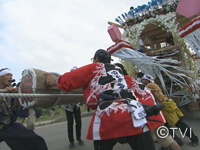
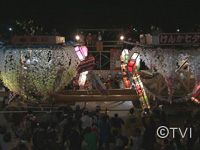
|Length : 48min. |Year : 2012 |
Imaizumi Ward, Kesencho, Rikuzen-Takata, Iwate Prefecture, Japan was a historic town that flourished since the Edo Period, and was home to some 2,000 residents in 550 households. Since the days of old, the connections between houses had been strong, and the town still retained the feel of a collective village community.
Kenka Tanabata, the Float Fighting Festival, has been a tradition here for over 900 years. Four groups from neighboring towns each made their own gorgeously decorated floats, then crashed them together full force in this 'rough and tumble' festival. For the locals it was the most important event of the year, with the townsmen preparing months in advance. People young and old looked forward to the festivities.
Then, on March 11, 2011, the Tohoku earthquake shook the region. A tidal wave over 10 meters high engulfed the town, destroying 99% of the homes. 230 people, some 10% of the local population, lost their lives. Where houses once stood in Imaizumi Ward, now is an empty wasteland. Former residents are now separated, relocated to various temporary housing complexes in outlying towns.
However, despite their daily struggle just to get by after the disaster, the townsmen were determined that the festival be continued. They feared that if the festival were discontinued, the people who had once lived here would forever lose their local spirit.
It will take at least 5 years to lay the groundwork for people to be able to live in the Imaizumi area again. For Imaizumi, the festival is the only remaining emblem of the town now razed to the ground; "Until people can come back and live here again..." On August 7th, 2012, at the site of the former main street, the townsmen recommenced the Kenka Tanabata Festival. They wanted to show everyone how not to give up.
Murone Shrine Grand Festival
DC271032![]()
守り続けて1300年 みちのくの荒祭り [KHB]
![]()
![]()
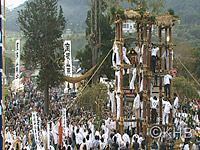
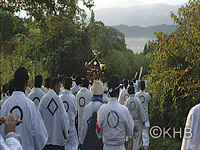
|Length : 30min. |Year : 2010 |
Murone Shrine was built in Mutsu Province (now Ichinoseki city in Iwate prefecture) when they re-enshrined a god, Kumano-no-kami, of the Kii Province during the Nara period, to pray for their success in conquering Ezo, or present day Hokkaido. This program captures the festival which is held to welcome the god. People who run the festival are called "Jin-yaku," and their role is passed down through the generations of families who can trace their lineage to the people who moved from the Province of Kii 1300 years ago. The highlight of this 3-day festival is the "Matsuriba event," held in the early morning on the third day. In complete darkness, two mikoshi, or portable shrines, are carried out and raced down the steep slope of a mountain. The race continues until the portable shrines are elevated and settled in their temporary location at the foot of the mountain. This program introduces the entire festival, while capturing the challenges of the people who face having to pass down these rituals to the next generation.















